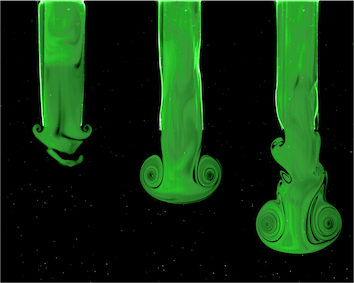
Fluid-structure Interaction
It is crucial to understand the solid-fluid interaction where a large amount of momentum is exchanged between them. For example, large-enough particles inside the ambient flow affect the global flow structure. Individual particles not only interacts with incoming flow condition but also are influenced by each other through their wakes. The elastic propulsor is another example, which amplifies the power expenditure through synchroized momentum transfer to/from surrounding fluids. To explore this fluid-solid interaction, I studied detailed flow structures using particle-image velocimetry accompanied with high-speed imaging and I have derived the governing equation which gives the relevant parameters as well as the optimizied initial condition for the maximum thrust. These findings have contributed to biology, medicine, multi-body behavior, energy harvesting, and industry.
Recent Publications
-
 Flow-structure interaction of the starting jet through the flexible circular nozzle
(Journal of Fluid Mechanics, 2022)
Flow-structure interaction of the starting jet through the flexible circular nozzle
(Journal of Fluid Mechanics, 2022)
The flow-structure interaction of the starting jet through the flexible nozzle is experimentally investigated depending on the nozzle stiffness and the jet condition. Through PIV and sub-pixel algorithm, it is found that the flexible nozzle modifies the vortical structure of the jet and augments the thrust of the starting jet. Combining the hydrodynamic conservation equations and the linearized shell theory, the optimal condition for the maximum thrust is derived and validated with measurements.
-
 Electroconvective circulating flows by asymmetric coulombic force distribution in
multiscale porous membrane
Electroconvective circulating flows by asymmetric coulombic force distribution in
multiscale porous membrane
(Journal of Membrane Science, 2021)The micro/nanofluidic device consisting of an array of ion-selective patches is developed so that micropores are formed between patches. Rigorous theoretical and experimental analysis on the electroconvective circulation near the membrane demonstrates that asymmetric coulombic force distribution among the micropores induces electroconvective circulating flows, leading to significant enhancement of ion transport and lowering resistivity of the entire system.
-
 Flow around in-line sphere array at moderate Reynolds number
Flow around in-line sphere array at moderate Reynolds number
(Physics of Fluids, 2018)We performed a series of water-tunnel experiments to investigate the flow around an in-line sphere array at the Reynolds number of 1000, focusing on how the sphere wake changes by the additional spheres located behind while the spacing between them is varied. To characterize the wake, we used 2D PIV to calculate the Strouhal number and flow statistics and we performed the dye visualization to identify the three-dimensional wake structure. Finally, the pressure reconstruction is applied to flow field data and shows the reduction of form drag due to the weakend wake strength.
Collaboration with Industry
-
 Development of medical devices for urinary surgery
Development of medical devices for urinary surgery
Collaborated with Yonsei Severance Hospital (2021)
Three granted patents (2022)The medical devices for unrinary surgery are developed with Yonsei medical school. First, in order to proactively determine whether the Foley catheter can be removed, equipment capable of receiving force and pressure inside the bladder is developed. Secondly, to reduce the friction between the ureter and sheath, the liquid jet is introduced inside the ureter to incur artificial hydronephrosis. We made monitoring devices including the wireless pressure and friction sensors, android-based application, and peristaltic pump. Using the combined shell theory, the critical pressure of the liquid jet is determined to generate sufficient hydronephrosis and to prevent the damage of the ureter.
Product demonstration video (in Korean)
Undergraduate Thesis (Main Advisor)
-
 Taechang Kim Seoul Nation University (2016)
Taechang Kim Seoul Nation University (2016)
Analysis of optimal shape of the rowing boat using flow visualization